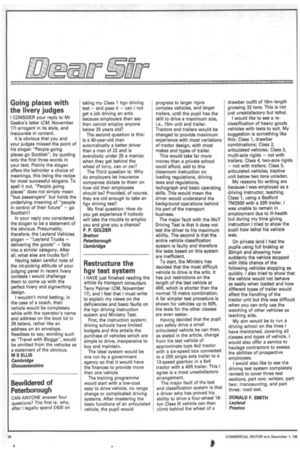Restructure the hgv test system
Page 26

If you've noticed an error in this article please click here to report it so we can fix it.
I HAVE just finished reading the article by transport consultant Terry Palmer (CM, November 17), and I feel that I must write to explain my views on the deficiencies and basic faults on the hgv driving instruction system and Ministry Test.
First, the instruction system; driving schools have limited budgets and this entails the purchase of vehicles which are simple to drive, inexpensive to buy and maintain.
The ideal system would be one run by a government agency so that it would have the finances to provide more than one vehicle.
The training programme would start with a low-cost easy to drive vehicle, no range change or complicated driving systems. After mastering the basic functions of an articulated vehicle, the pupil would progress to larger rripre complex vehicles, and larger trailers, until the pupil has the skill to drive a maximum size, i.e., 15m unit and trailer. Tractors and trailers would be changed to provide maximum experience with most variations of tractor design, with most makes and types of trailer.
This would take far more money than a private school could afford, add to this classroom instruction on loading regulations, driving laws and regulations, tachograph and basic operating skills. This would mean the driver would understand the background operations behind his part of the transport business.
The major fault with the MoT Driving Test is that it does not test the driver to his maximum ability. The second is that the entire vehicle classification system is faulty and therefore the tests based on this system are inefficient.
To start, the Ministry has decided that the most difficult vehicle to drive is the artic. It has put restrictions on the length of the test vehicle at 45ft, which is shorter than the normal 15 metre combination. A far simpler test procedure is shown for vehicles up to 60ft, the tests for the other classes are even easier.
Having decided that the pupil can safely drive a small articulated vehicle he can then, as stated in the article, change from his test vehicle of approximate type 4x2 tractor with a six-speed box connected to a 25ft single axle trailer to a 13-speed gearbox in a 6x4 tractor with a 40ft trailer. This I agree is a most unsatisfactory arrangement.
The major fault of the test and classification system is that a driver who has proved his ability to drive a four-wheel 16ton Class III vehicle can then climb behind the wheel of a drawbar outfit of 18m length grossing 32 tons. This is not just unsatisfactory but lethal.
I would like to see a reclassification of heavy goods vehicles with tests to suit. My suggestion is something like this: Class 1, drawbar combinations; Class 2, articulated vehicles; Class 3, multi-axle rigids — not with trailers; Class 4, two-axle rigids — not with trailers; Class 5, articulated vehicles, tractive unit below two tons unladen.
My reasons for writing are because I was employed as a driving instructor, teaching Class 1, using a Bedford TM2500 with a 33ft trailer. I was unable to remain in employment due to ill-health but during my time giving instruction I tried to show the pupil how lethal his vehicle was.
On private land I had the pupils using full braking at 30mph and showing how suddenly the vehicle stopped with little chance of the following vehicles stopping as quickly. I also tried to show that the vehicle would not behave as easily when loaded and how different types of trailer would affect the handling of the tractor unit but this was difficult when you can only use the watching of other vehicles as teaching aids.
My aim would be to run a driving school on the lines I have mentioned, covering all classes and types of vehicle. I would also offer a service to haulage contractors to assess the abilities of prospective employees.
I would also like to see the driving test system completely revised to cover three test sections, part one: written, part two: manoeuvring, and part three: road test.
DONALD F. SMITH Leyland Preston




























































































